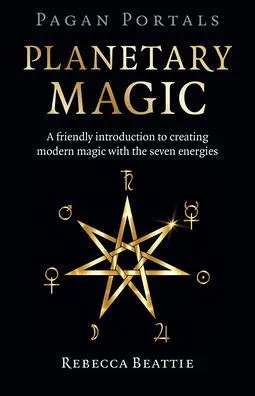For millennia—and prior to the use of telescopes and the discovery of planets not visible to the human eye--the mainstays of astrological practice have been the Sun and Moon (the “lights”) and the five visible planets: Mercury, Venus, Mars, Jupiter, and Saturn.
In this handy primer, Rebecca Beattie shows how to use the energies of these seven bodies in magical practice. Planetary Magic is especially geared for readers new to magical practice, including those who may not yet be studied in the intricacies of astrology. The starting point is the two lights, the five planets, and their correspondences in the material world and in our psyches. The powers of these seven are so profound that one could spend a lifetime mining their depths.
Rebecca Beattie holds a Ph.D. in creative writing from Middlesex University. She’s the author of several works of fiction, including a novel about nature writer Mary Webb, as well as the Pagan Portals book Nature Mystics: The Literary Gateway to Modern Paganism.
Beattie’s new book Planetary Magic begins with a check a list of “magical problems and planetary solutions” – examples include abundance, grief, health, sex, travel, and so on – so that a reader can identify the relevant planet(s) and then proceed to the chapter for that planet. The bulk of the book is based on a course of seven monthly workshops Beattie taught, especially for young witches and, during the pandemic, online. For each workshop, she taught about the planet’s symbols, its cross-cultural correspondences with deities, and how to creatively play with each planet’s energies. This is also one of the best ways to study astrology: start by knowing the planets and the lights, before then learning how they function in houses, and how they are modified by signs.
Each chapter in Planetary Magic includes an Orphic Hymn, a note about the planet’s relationship with the elements, its sigils, recipes for oils and incenses, correspondences with days of the week and with tarot cards, sample spells, and brief paragraphs about deities who are a planet’s “cousins and counterparts.” Included are multi-cultural deities, beyond the Greek and Roman pantheons.
Fittingly, in the chapter about multi-tasker Mercury, we read about Loki, the Norse trickster god, and also about Ganesh, the elephant-headed, shape-shifting son of Parvati and Shiva. Beattie writes that Ganesh, known as “the remover of obstacles,” is similar to Papa Legba, a Haitian Voudo god. These “cousins and counterparts” share the mercurial quality of operating between worlds. I was excited to read this because before reading this book, I had not made the connection between Ganesh, the obstacle remover, and the betwixt and between character of Mercury. It’s one of the gems I found in Planetary Magic.
Beattie’s larger point, amidst all the practical information, is that a magical practice need not look anything like the stereotype of going to the woods and “collecting rose petals in hand made wicker baskets.” In an urban life-- or wherever one is-- a magical practice need not conform to prescriptions or media images.
Instead, Beattie offers a cogent explanation of how magic works. “Did you know you have two different minds?” she asks. The conscious mind is the part that thinks with logic and words. The unconscious mind handles infinitely more information. The unconscious mind doesn’t “do language.” It works with pictures, symbols colors, tastes, and stories, filtering out what is not needed and encouraging what is needed.
“Your conscious mind is there to imprint your will, to help you state your intention, and the unconscious mind is there to make it happen,” she writes. The unconscious mind is the source of magic.
Working with the seven planetary powers is a way to practice communicating with one’s unconscious mind, and to make things happen. This book is a useful guide.
~review by: Sara R. Diamond
Author: Rebecca Beattie
Moon Books, 2023
133 pp., $12.95

